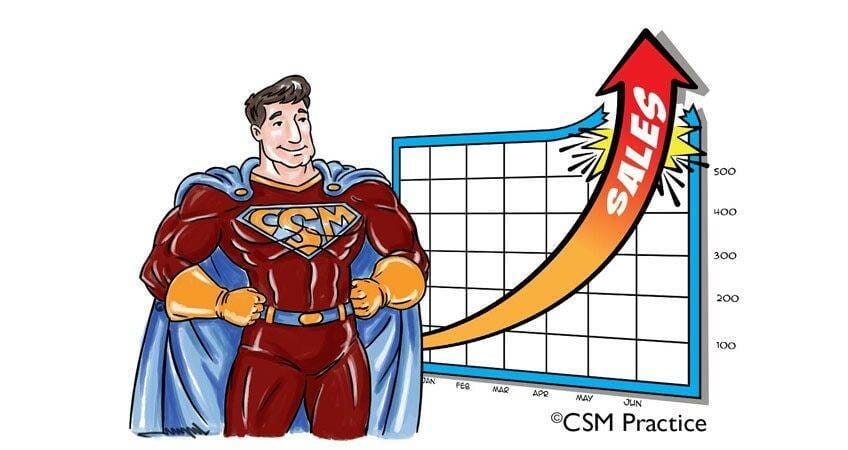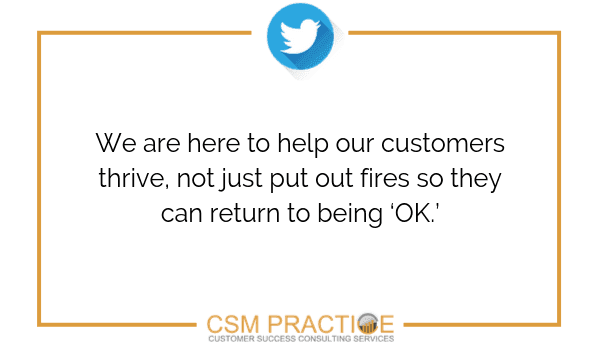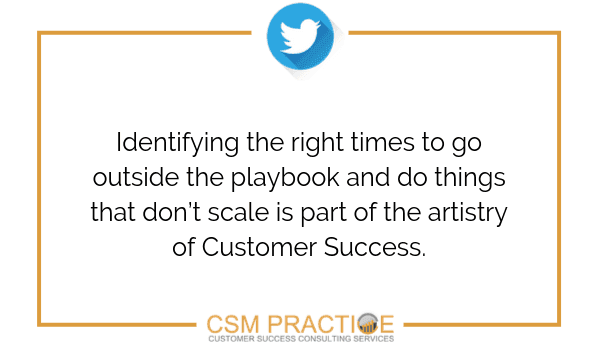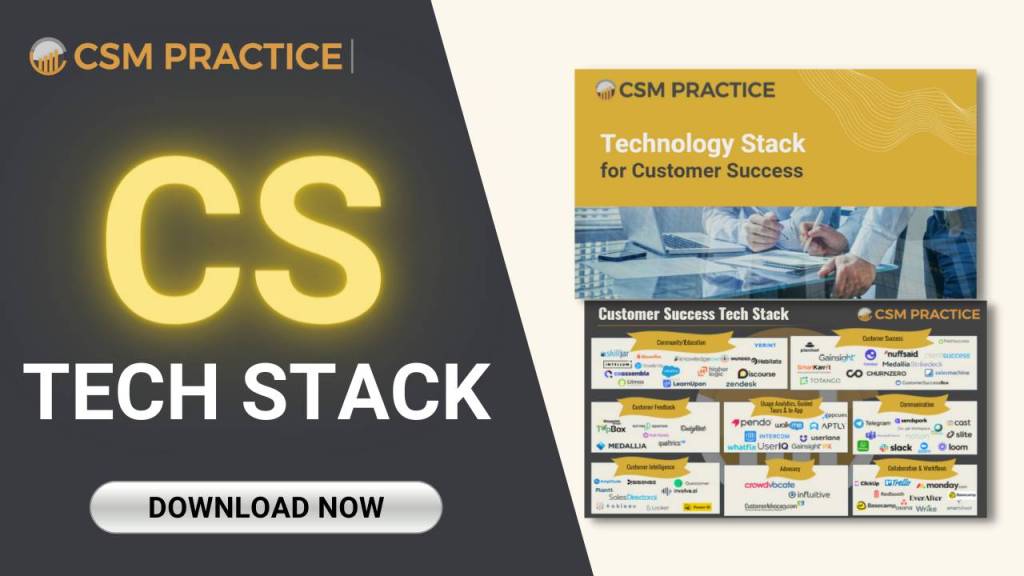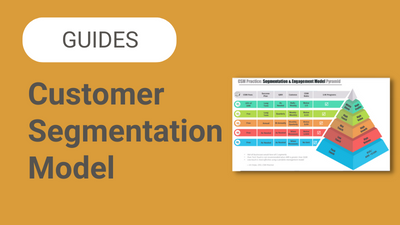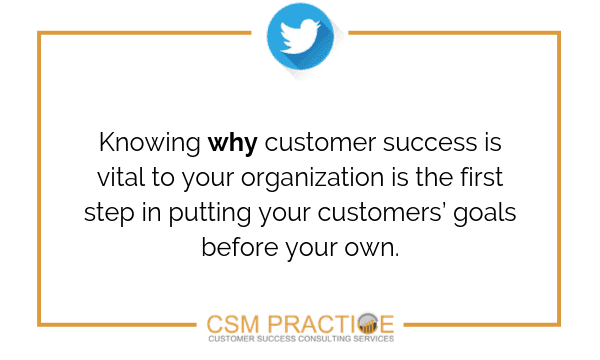In one of my previous articles, I shared how Quuu co-founder Daniel Kempe took the time to learn more about my experience with their product. Daniel’s attention to detail left me with a far better appreciation of their service, even though I had already determined it wasn’t quite right for me. Normally, it wouldn’t make sense for a Tech Touch founder like Daniel to go out of his way to connect with me. Daniel knew. I wasn’t his ideal customer as soon as we started talking, so what made him take extra steps to guarantee my success?
In an even broader sense, what is the role of non-scalable activities in driving Customer Success? How can we transform these types of actions into greater success for our entire customer base? Finally, how can we transform Potential Value in the form of future up-sells and qualified referrals from prospects (hypothetical guesswork), into Consistent Value in the form of higher revenue from existing customers who are close to being Ideal?
Plan For Your Customers’ Success, Not Your Own
This attitude defines the modern Customer Success movement, yet there’s so much room for improvement. For an example of this, it’s helpful to look at the origins of Airbnb. The founders realized that if they couldn’t help their primary customers (homeowners renting out their space), they’d have no hope of helping their ultimate customers (guests).
So they did something completely unexpected:
They flew from San Francisco to New York and personally visited everyone who was listing their property on the site, and coached them on taking better pictures. They could have set-up a conference call, they could have outsourced it to a New York photographer, they could have done any of a million other things besides spending a few thousand dollars at a time when they were only making $200 per week. But they realized that the best way for them to ensure their customers’ success – both immediately and far into the future – was by taking drastic action that couldn’t be scaled.
Let’s return to Daniel and his team at Quuu, and how they responded to my request to cancel my account. From a Customer Service perspective, the best response by-the-book would have been to respond politely and quickly, in anticipation of the next call for help. If you’re still reading that book please burn it: we’re here to help our Customers thrive, not just put out fires so they can return to being ‘OK.’ Daniel knew he had a great opportunity to learn from my experience, that my challenges might make all his other customers more successful. Our conversation impressed me so much, that when I decided to analyze it as a case study of churn I sought his perspective on the article before I published it. Daniel’s co-founder Matthew Spurr offered some incredible feedback and suggestions which made the entire article better, just as I hope they’re considering my feedback in improving Quuu.
Here’s the best part: Daniel and Matthew wanted to make sure I had the best experience, even while I was planning to stop using their service. The way in which they did it would be difficult to scale, but their motivation lies at the heart of Customer Success:
- In the Transaction Economy, where the seller claims all the power, we see restrictive contracts with heavy penalties for early cancellation and large upfront costs. The goals are to prevent churn (or at least make it more painful for the buyer) and protect the seller if the buyer decides to leave. This business model is obsolete.
- When the seller offers all the power to the buyer, as we see in today’s Subscription Economy, it becomes immediately apparent that the seller’s success depends on the buyer’s success. The former cannot precede the latter.
With this new attitude, it makes perfect sense to look beyond our own pressing needs to “preserve revenue” and “prevent churn,” and to start thinking strategically about how we can help our customers throughout our relationship, even if they do end up churning. How can you make their experience so overwhelmingly positive that the moment they churn is just another milepost on their journey? Daniel and Matt did such a great job of listening to my goals, that after our discussion I decided to purchase their service Quuu Promote at the highest tier. This product matched my needs much more closely, but even more importantly the founders had already earned my trust.
You cannot scale if you’re stuck in reactionary mode, or if you’re reading from a script. Occasionally you need to add a new page to the playbook or rip out pages that don’t make any sense. Each of your customers is unique, which leads to a beautiful paradox: if your ultimate goal is to scale, then you need to fine-tune your approach with every customer interaction.
Data: The Right Approach and The Right People
Identifying the right times to go outside the playbook and do things that don’t scale is part of the artistry of Customer Success. These moments help build trust at times when it might seem like the relationship is beyond saving. But you also need the other side of the coin: Science. And all science starts with a hypothesis and the methodical collection of data.
Yet what a tremendous amount of data! If you’re currently using a Customer Success Management platform like Gainsight, or even if you’re only beginning to consider implementing such a platform, you know how overwhelming it can be to parse it all. Just having the data is one thing, but putting it to good use is how we turn Potential ROI into concrete, Consistent ROI.
And this requires some very un-scalable, potentially painful things:
Segmentation
The zeroth thing to do with your data is set it aside, and consider who you’re serving: Which of your customers is High Touch, Low Touch, or Tech Touch? What are the criteria you will use to define who is in each segment? Which customer activities will confirm your choice of that segment? Which customer activities alert you that you need to move them to a new segment? Your answers to these questions will vary based on the unique Key Performance Indicators (KPIs) of your business. But choose wisely, because the decisions you make today will have a huge impact on the following areas:
- How will Support manage tickets and escalations?
- How will Sales and Marketing treat leads and prospects?
- How much time will Customer Success Managers devote to each of their accounts?
Proper segmentation of your customer base helps you answer all these questions and thousands more. The key is to specify an owner for every single Touchpoint on your customers’ journey since this is the best way to leverage the mountains of data you are accumulating. Ideally, you would know what each customer is facing at any given time (specific to their segment); who is responsible for shepherding them from one Touchpoint to the next; what will happen when they get there; and what goals they’re planning to achieve along the way. If you leave any of these steps to chance, you’re not making the best use of your data, and your customer’s trust in your service will suffer.
Our goal is to instill a greater sense of predictability in our work, and this requires making big decisions upfront that would be painful or paralyzing to do on a frequent basis. Creating proper segments early in the evolution of your company would be one of the most valuable steps you can take to secure higher recurring revenue for years to come.
Because the alternative – treating all your customers the same – is definitely not scalable.
Right People, Right Roles, Right Time
Your data is priceless, not only for your Customer Success team, but also for Sales, Marketing, Support, Product, and every other business unit within your company. Without data, decisions are no better than guesses and reactions boil down to fear.
So, what would you say if I told you that your data is also utterly worthless?
You know you’re sitting on a gold mine, you have a fairly good idea of how you want to use it to help your customers thrive… but who will you trust to make your vision a reality? Everything that you want to do for your most valuable customers, every step you want to take to ensure their long-term success, take these same steps with your employees first.
The article I just cited examines the parallels between your Best Customers and your Best Employees. Here’s what bringing the Right People onto your team can do for your data:
- The Right People know how to gather the right data
- The Right People know what to do to improve sub-optimal data
- The Right people don’t have to be “Managed” to leverage that data for maximum benefit to your customers.
Owning a gold mine doesn’t mean anything unless you invest sweat equity to get it out of the ground, just like your data doesn’t mean anything without empowered, strategically-minded professionals. Yet selecting the Right People for your team is one of the most challenging parts of the business. This is the part that’s hard to scale, which is why it’s so important to do it correctly from the beginning. Within Customer Success and across your organization, your team members’ strengths and weaknesses will only be revealed when they work with others. The Right People are excited by audacious goals and a clear path to victory, but their passion can be extinguished by the Wrong People. This dynamic is very similar to what happens when you spend too much time serving the Wrong Customers: everyone loses.
Summary
Knowing Why Customer Success is vital to your organization is the first step in putting your customers’ goals before your own. Segmenting your customers and turning the Right People loose on good Data answers the question of How you’re going to serve them. When you have all these pieces in place, the What – the exact details of your product suite – become a bit less important. When you focus on Why and How, you’re ready to help all your customers achieve their goals, no matter what their goals might look like or how they might change over time.
That’s how you scale!

